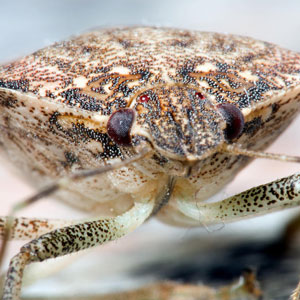What’s Happening With the Brown Marmorated Stink Bug?
By Chris Williams on October 18, 2013.
 We’re right in the middle of the time of year when stink bugs try to move into our homes to spend the winter. In New England, so far, we have been lucky. While the brown marmorated stink bug (BMSB) has been detected in every state in New England, it remains primarily a nuisance pest in Massachusetts and New Hampshire. In New York state, it is more of a problem but the Mid-Atlantic states continue to be ground zero for the brown marmorated stink bug. In these states, fruit growers have been hard hit. While the BMSB first became a problem in the Mid-Atlantic states just a few years, it is now found in 40 states and from coast to coast.
We’re right in the middle of the time of year when stink bugs try to move into our homes to spend the winter. In New England, so far, we have been lucky. While the brown marmorated stink bug (BMSB) has been detected in every state in New England, it remains primarily a nuisance pest in Massachusetts and New Hampshire. In New York state, it is more of a problem but the Mid-Atlantic states continue to be ground zero for the brown marmorated stink bug. In these states, fruit growers have been hard hit. While the BMSB first became a problem in the Mid-Atlantic states just a few years, it is now found in 40 states and from coast to coast.
Although stink bugs can decimate crops, for most of us, stink bugs become an issue only when they try to spend the winter in our homes. And those infestations can be spotty since the BMSB usually moves into homes from nearby crop fields or orchards. In areas where BMSBs are plentiful, some homes near stink bug populations will be inundated with stink bugs, while others see none. How “tight” or pest-proof your home is will be a factor, too.
First Priority – Keep Them Out!
The National Pest Management Association offers the following tips for dealing with stink bugs in your home:
Seal off entry points
Inspect the outside of your home for openings where stink bugs can get in. Pay close attention to areas around utility pipes and lines, around chimneys, and under fascia near the roofline. Caulk and seal cracks and holes.
Replace and repair
Check for damaged window, door, or vent screens, and for torn weather-stripping and loose mortar.
Turn off the lights
Keep outdoor lighting that attracts the bugs to a minimum. During the evenings, turn off porch lights and pull down window blinds to prevent light spilling outside.
Ventilate
Properly ventilate and dehumidify basements, attics, garages, and crawlspaces to eliminate the damp hiding places that stink bugs like.
Think before squishing
When disturbed or crushed, the BMSB releases a bad odor that some say smells like cilantro. Instead, use a vacuum cleaner to remove them, and be sure to empty the vacuum bag immediately to prevent odor problems.
Photo credit: e_monk / Foter / CC BY-NC-SA